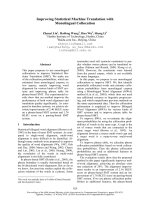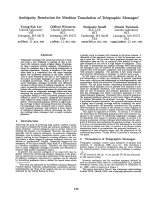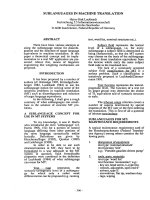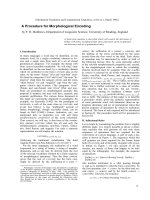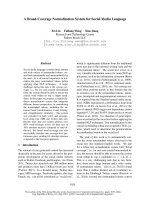Báo cáo khoa học: "A ROBUST MACHINE TRANSLATION SYSTEM" doc
Bạn đang xem bản rút gọn của tài liệu. Xem và tải ngay bản đầy đủ của tài liệu tại đây (540.64 KB, 7 trang )
JETR: A ROBUST MACHINE TRANSLATION SYSTEM
Rika Yoshii
Department of Information and Computer Science
University of California, Irvine,
Irvine, California, 92717 t
ABSTRACT
This paper presents an expectation-based Japanese-
to-English translation system called JETR which relies
on the forward expectation-refinement process to
handle ungrammatical sentences in an elegant and
efficient manner without relying on the presence of
particles and verbs in the source text. JETR uses a
chain of result states to perform context analysis for
resolving pronoun and object references and filling
ellipses. Unlike other knowledge-based systems, JETR
attempts to achieve semantic, pragmatic, structural and
lexical invariance.
INTRODUCTION
Recently there has been a revitalized interest in
machine translation as both a practical engineering
problem and a tool to test various Artificial
Intelligence (AI) theories. As a result of increased
international communication, there exists today a
massive Japanese effort in machine translation.
However, systems ready for commercialization are still
concentrating on syntactic information and are unable
to translate syntactically obscure but meaningful
sentences. Moreover, many of these systems do not
perform context analysis and thus cannot fill ellipses
or resolve pronoun references. Knowledge-based
systems, on the other hand, tend to discard the syntax
of the source text and thus are unable to preserve the
syntactic style of the source text. Moreover, these
systems concentrate on understanding and thus do not
preserve the semantic content of the source text.
An expectation-based approach to "Japanese-to-
English machine translation is presented. The
approach is demonstrated by the JETR system which is
designed to translate recipes and instruction booklets.
Unlike other Japanese-to-English translation systems,
which rely on the presence of particles and main verbs
in the source text (AAT 1984, Ibuki 1983, Nitta 1982,
tThe author is now located at:
Rockwell International Corp.
Autonetics Strategic Systems Division
Mail Code: GA42
3370 Miraloma Avenue, P.O. Box 4192
Anaheim, California 92803-4192
Saino 1983, Shimazu 1983), JETR is designed to
translate ungrammatical and abbreviated sentences
using semantic and contextual information. Unlike
other knowledge-based translation systems
(Cullingford 1976, Ishizaki 1983, Schank 1982, Yang
1981), JETR does not view machine translation as a
paraphrasing problem. JETR attempts to achieve
semantic, pragmatic, structural and lexical invariance
which (Carbonell 1981) gives as multiple dimensions
of quality in the translation process.
Sends phrases, wood
d~sses and phrase roles
[Analyzer[
(PDA) ,~
Sends object frames
Sends object framms
and action frames
Sends modified expectations,
modified object types and
filled frames
Generator
I
Resolves Sends
an~hofic object
references frames
I Context
Analyzer I
Figure
1.
JETR Components
JETR is comprised of three interleaved components:
the particle-driven analyzer, the generator, and the
context analyzer as shown in Figure 1. The three
components interact with one another to preserve
information contained in grammatical as well as
ungrammatical texts. The overview of each component
is presented below. This paper focuses on the particle-
driven analyzer.
CIIARACTERISTICS OF TilE JAPANESE LANGUAGE
The difficulty of translation depends on the
similarity between the languages involved. Japanese
and English are vastly different languages. Translation
from Japanese to English involves restructuring of
sentences, disambiguation of words, and additions and
25
deletions of certain lexical items. The following
characteristics of the Japanese language have
influenced the design of the JETR system:
1. Japanese is a left-branching, post-
positional, subject-object-verb language.
2.
Particles and not word order are important
in determining the roles of the noun
phrases in a Japanese sentence.
.
Information is usually more explicitly
stated in English than in Japanese. There
are no articles (i.e. "a",
"an",
and
"the").
There are no singular and plural forms of
nouns. Grammatical sentences can have
their subjects and objects missing (i.e.
ellipses).
PDA:
PARTICLE-DRIVEN ANALYZER
Observe
the
following sentences:
Verb-deletion:
Neji (screw) o (object marker) migi (right) e
(direction marker) 3 kurikku (clicks).
Particle-deletion:
Shin (salt) keiniku (chicken) ni (destination
marker) furu (sprinkle).
The first sentence lacks the main verb, while the
second sentence lacks the particle after the noun
"shin." The role of "shin" must be determined
without relying on the particle and the word order.
In addition to the problems of unknown words and
unclear or ambiguous interpretation, missing particles
and verbs are often found in recipes, instruction
booklets and other informal texts posing special
problems for machine translation systems. The
Particle-Driven Analyzer (PDA) is a robust
intrasentence analyzer designed to handle
ungrammatical sentences in an elegant and efficient
manner.
While analyzers of the English language rely
heavily on verb-oriented processing, the existence of
particles in the Japanese language and the subject-
object-verb word order have led to the PDA's reliance
on forward expectations from words other than verbs.
The PDA is unique in that it does not rely on the
presence of particles and verbs in the source text. To
take care of missing particles and verbs, not only
verbs but all nouns and adverbs are made to point to
action frames
which are structures used to describe
actions. For both grammatical and ungrammatical
sentences, the PDA continuously
combines and refines
forward expectations from various phrases to determ/ne
their roles and to predict actions.
These expectations
are semantic in nature and disregard the word order of
the sentence. Each expectation is an action-role pair of
the form (<action> <role>). Actions are names of
action frames while roles correspond to
the
slot names
of action frames. Since the main verb is almost always
found at the end of the sentence, combined forward
expectations are strong enough to point to the roles of
the nouns and the meaning of the verb. For example,
consider "neji (screw) migi (right) • 3 kurikku
(clicks)." By the time, "3 clicks" is read, there are
strong expectations for the act of turning, and the
screw expects to be the object of the act.
Input: <muM> o ~ ~ <verb>
(al ~e~) J2
(a3 ~$Una~)
(a4 des~na~on)
(al oqect)
(al iN;~ument)
(a3 destination) 4
Intersection:
(a2 oqe~ (~ dasdna~on) (a2 desdnaton)
Figure 2. Expectation Refinement in the PDA
Figure 2 describes the forward expectation-
refinement process. In order to keep the expectation
list to a manageable size, only ten of the most likely
roles and actions are attached to each word.
Input:.
Expectations:
<noun1>
m
Intersection:
(at ~ .(al ~j~
a2
a3
(~e~ [ (~o.) 4 nounl ~e~t'~
(a4 deshion). /
9ene~ole tier
(at
oqd
(~) ,
,mp~
Figure 3. Expectation Mismatch in the
PDA
The PDA is similar to IPP (Lebowitz 1983) in that
words other than verbs are made to point to structures
which describe actions. However, unlike IPP, a generic
role-filling process will be invoked
only
if an
26
unexpected verb is encountered or the forward
expectations do not match. Figure 3 shows such a
case. The verb will not invoke any role-filling or
role-determining process ff the semantic expectations
from the other phrases match the verb. Therefore, the
PDA discourages inefficient verb-initiated backward
searches for role-fillers even when particles are
missing.
Unlike LUTE (Shimazu 1983), the PDA's generic role-
filling process does not rely on the presence of
particles. To each slot of each action frame, acceptable
filler types are attached. When particles are missing,
the role-filling rule matches the object types of role
fillers against the information attached to action
frames. The object types in each domain are organized
in a hierarchy, and frame slots are allowed to point to
any level in the hierarchy.
Verbs with multiple meanings are disambiguated by
starting out with a set of action frames (e.g. a2 and a3)
and discarding a frame if a given phrase cannot fill any
slot of the frame.
The PDA's processes can be summarized as follows:
1.
Grab a phrase bottom-up using syntactic
and semantic word classes. Build an object
frame if applicable.
2. Recall all expectations (action-role pairs)
attached to the phrase.
3.
4.
If a particle follows, use the particle to
refine the expectations attached to the
phrase.
Take the intersection of the old and new
expectations.
5. If the intersection is empty, set a flag.
6.
7.
If this is a verb phrase and the flag is up,
invoke the generic role-filling
process.
Else if this is the end of a simple
sentence, build an action frame using
forward expectations.
8.
Otherwise go back
to
Step 1.
To achieve extensibility and flexibility, ideas such as
the detachment of control structure from the word
level, and the combination of top-down and bottom-up
processing have been incorporated.
SIMULTANEOUS GENERATOR
Certain syntactic features of the source text can
serve as functionally relevant features of the situation
being described in the source text. Preservation of
these features often helps the meaning and the nuance
to be reproduced. However, knowledge-based systems
discard the syntax of the original text. In other words,
the information about the syntactic style of the source
text, such as the phrase order and the syntactic classes
of the original words, is not found in the internal
representation. Furthermore, inferred role fillers, causal
connections, and events are generated disregarding the
brevity of the original text. For example, the
generator built by the Electrotechnical Laboratory of
Japan (Ishizaki 1983), which produces Japanese texts
from the conceptual representation based on MOPs
(Schank 1982), generates a pronoun whenever the
same noun is seen the second time. Disregarding the
original sentence order, the system determines the
order using causal chains. Moreover, the subject and
object are often omitted from the target sentence to
prevent wordiness.
Unlike other knowledge-based systems, JETR can
preserve the syntax of the original text, and it does so
without building the source-language tree. The
generation algorithm is based on the observation that
human translators do not have to wait until the end of
the sentence to start translating the sentence. A human
translator can start translating phrases as he receives
them
one at a time
and can apply partial syntax-
transfer rules as soon as he notices a phrase sequence
which is ungrammatical in the target language.
Verb Deletion:
Shio o Ilikiniku hi.
Mizu wa nabe hi.
SaJt on ground meat.
As for the water, in a poL
Par~cle Deletion:
Hikiniku, shio o furu. ~ Ground meat, sprinkle sail
Word Order Preservation:
o-kina fukai nabe ~ big deep
pot
fukai o-kina nabe ~ deep big pot
Le~cal ~nveriance:
200 g no hikiniku o
itameru. Kosho- o
hikiniku ni futte
susumeru.
Stir-fry 200g of ground
meat. Sprinkle pepper on
the ground meat;, serve.
2009 no hikiniku o
itameru. Kosho- o
sore ni futte susumeru.
Stir-fry 200g of ground
meat. Sprinkle pepper
on it; serve.
Figure 4. Style Preservation In the Generator
The generator does not go through the complete
semantic representation of each sentence built by the
other components of the system. As soon as a phrase
is processed by the PDA, the generator receives the
phrase along with its semantic role and starts
generating the phrase if it is unambiguous. Thus the
generator can easily distinguish between inferred
information and information explicitly present in the
27
source text. The generator and
not the
PDA calls the
context analyzer to obtain missing information that
are needed to translate grammatical Japanese sentences
into grammatical English sentences. No other inferred
information is generated. A preposition is not
generated for a phrase which is lacking a particle, and
an inferred verb is not generated for a verb-less
sentence. Because the generator has access to the
actual words in the source phrase, it is able to
reproduce frequent occurrences of particular lexical
items. And the original word order is preserved as
much as possible. Therefore, the generator is able to
preserve idiolects, emphases, lengths, ellipses, syntax
errors and ambiguities due to missing information.
Examples of target sentences for special cases are
shown in Figure 4.
To achieve structural invariance, phrases are output
as soon as possible without violating the English
phrase order. In other words, the generator pretends
that incoming phrases are English phrases, and
whenever an ungrammatical phrase sequence is
detected, the new phrase
is
saved in one
of
three
queues: SAVED-PREPOSITIONAL, SAVED-REFINER,
and SAVED-OBJECT, As long as no violation of the
English
phrase
order is
detected
or
expected, the
phrases are generated immediately. Therefore, no
source-language tree needs to be constructed, and no
structural information needs to be stored in the
semantic
representation of the complete sentence.
To prevent awkwardness, a small knowledge base
which relates source language idioms to those of the
target language is being used by JETR; however, one
problem with the generator is that it concentrates too
much on information preservation, and the target
sentences are awkward at times. Currently, the system
cannot decide when to sacrifice information
preservation. Future research should examine the
ability of human transla~rs to determine the important
aspects of the source text.
INSTRA:
Tile CONTEXT ANALYZER
The context analyzer component of JETR is called
INSTRA (INSTRuction Analyzer).
The
goal of INSTRA
is to aid the other components in the following ways:
I. Keep track of the changes in object types
and forward expectations as objects are
modified by various modifiers and actions.
.
Resolve pronoun references
so
that correct
English pronouns can be generated and
expectations and object types can be
associated with pronouns.
.
Resolve object references so that correct
expectations and object types can be
associated with objects and consequently
the article and the number of each noun
can be determined.
4. Choose among the multiple interpretations
of a sentence produced by the PDA.
.
Fill ellipses when necessary so that well-
formed English sentences can be
generated.
In knowledge-based systems, the context analyzer is
designed with the goal of natural-language
understanding in mind; therefore, object and pronoun
references are resolved, and ellipses are filled as a by
product of understanding the input text. However,
some human translators claim that they do not always
understand the texts they translate (Slocum 1985).
Moreover, knowledge-based translation systems are
less practical than systems based on direct and transfer
methods. Wilks (1973) states that " it may be
possible to establish a level of understanding
somewhat short of that required for question-answering
and other intelligent behaviors." Although
identifying the level of understanding required in
general by a machine translation system is difficult,
the. level clearly depends on the languages, the text
type and the tasks involved in translation. INSTRA
was designed with the goal of identifying the level of
understanding required in translating instruction
booklets from Japanese to English.
A unique characteristic of instruction booklets is
that every action produces a clearly defined resulting
state which is a transformed object or a collection of
transformed objects that arc likely to be referenced by
later actions. For example, when salt is dissolved into
water, the salty water is the result. When a screw is
turned, the screw is the result. When an object is
placed into liquid, the object, the liquid, the container
that contains the liquid, and everthing else in the
container are the results. INSTRA keeps a
chain of the
resulting states
of the actions. INSTRA's five tasks all
deal with searches or modifications of the results in
the chain.
-
bgreoients
-
OBJ RICEV~IT 3 CUPS~ALIAS INGO
OBJ WING~DJ CHICKEI~MT 100 TO 120 GRAMS~LIAS ING1
OBJ EGGV~MT 4~,LIAS ING2
OBJ BAMBOO:SHOOT~DJ BOILEDV~.MT 40 GRAMSU~IAS ING3
OBJ ONIONV~.DJ SMALL~AMT I~LIAS ING4
OBJ SHIITAKE:MUSHROOMV~DJ FRESH~AMT 2~ALIAS INGS
OEJ LAVERV~MT AN APPROPRIATE AMOUNT~,LIAS ING6
OBJ MITSUBA'tAM'T A SMALL AMOUntS ING7
- the rk:e is bo]h~:l -
STEP10BJ RICE~,LIAS INGOV~T I~EFPLURAL T
- the chicken, onion, bamboo shoots, mushrooms and mitsuba ate cut.
STEP20BJ CHICKEN'tALIAS INGI~RT '1~REF PLURAL T
STEP20BJ ONION~IAS ING4~ART T
STEP20BJ BAMBOO:SHOOT ~ALIAS ING3IART T~REFPLURAL T
STEP2 08J SHIITAKE:MUSHROOM~ FRESHV~LIAS ING5~RT
REFPLURAL T
STEP20BJ MITSUBAV~J.IAS INGT~ART T
Figure
S. Chain
or State= Used
by INSTRA
28
To keep track of the state of each object, the object
type and expectations of the object are changed
whenever certain modifiers are found. Similarly, at the
end of each sentence, 1) the object frames representing
the result objects are extracted from the frame, 2) each
result object is given a unique name, and 3) the type
and expectations are changed if necessary and are
attached to the unique name. To identify the result of
each action, information about what results from the
action is attached to each frame. The result objects are
added to the end of the chain which may already
contain the ingredients or object components. An
example of a chain of the resulting states is shown in
Figure 5.
In instructions, a pronoun always refers to the result
of the previous action. Therefore, for each pronoun
reference, the unique name of the object at the end of
the chain is returned along with the information about
the number (plural or singular) of the object.
For an object reference, INSTRA receives an object
frame, the chain is searched backwards for a match, and
its unique name and information about its number are
returned. INSTRA uses a set of rules that takes into
account the characteristics of modifiers in instructions
to determine whether two objects match. Object
reference is important also in disambiguating item
parts. When JETR encounters an item part that needs
to be disambiguated, it goes through the chain of
results to find the item which has the part and retrieves
an appropriate translation equivalent. The system uses
additional specialized rules for step number references
and divided objects.
Ellipses are filled by searching through the chain
backwards for objects whose types are accepted by the
corresponding frame slots. To preserve semantic,
pragmatic and structural information, ellipses are filled
only
when 1) missing information is needed to
generate grammatical target sentences, 2) INSTRA must
choose among the multiple interpretations of a
sentence produced by the PDA, or 3) the result of an
action is needed.
The domain-specific knowledge is stated solely in
terms of action frames and object types. INSTRA
accomplishes the five tasks I) without pre-editing and
post-editing, 2) without relying on the user except in
special cases involving unknown words, and 3)
without fully understanding the text. INSTRA assumes
that the user is monolingual. Because the method
refrains from using inferences in unnecessary cases,
the semantic and pragmatic information contained in
the source text can be preserved.
CONCLUSIONS
This paper has presented a robust expectation-based
approach to machine translation which does not view
machine translation as a testhod for AI. The paper has
shown the need to consider problems unique to
machine translation such as preservation of syntacite
and semantic information contained in grammatical as
well as ungrammatical sentences.
The integration of the forward expectation-
refinement process, the interleaved generation
technique and the state-change-based processing has
led to the construction of an extensible, flexible and
efficient system. Although JETR is designed to
translate instruction booklets, the general algorithm
used by the analyzer and the generator are applicable
to other kinds of text. JETR is written in UCI LISP on
a DEC system 20/20. The control structure consists of
roughly 5500 lines of code. On the average it takes
only 1 CPU second to process a simple sentence.
JETR has successfully translated published recipes
taken from (Ishikawa 1975, Murakami 1978) and an
instruction booklet accompanying the Hybrid-H239
watch (Hybrid) in addition to hundreds of test texts.
Currently the dictionary and the knowledge base are
being extended to translate more texts.
Sample translations produced by JETR are found in
the appendix at the end of the paper.
REFERENCES
AAT. 1984. Fujitsu has 2-way Translation System.
AAT Report 66. Advanced American
Technology, Los Angeles, California.
CarboneU, J. G.; Cullingford, R. E. and Gershman, A.
G. 1981. Steps Toward Knowledge-Based
Machine Translation.
IEEE Transaction on
Pattern Analysis and Machine Intelligence
PAMI, 3(4).
Cullingford, R. E. 1976. The Application of Script-
Based Knowledge in an Integrated Story
Understanding System. Proceedings of
COLING-1976.
Granger, R.; Meyers, A.; Yoshii, R. and Taylor, G.
1983. An Extensible Natural Language
Understanding System. Proceedings of the
Artificial Intelligence Conference, Oakland
University, Rochester, Michigan.
Hybrid. Hybrid cal. H239 Watch Instruction Booklet.
Seiko, Tokyo, Japan.
Ibuki, J; et. al. 1983. Japanese-to-English Title
Translation System, TITRAN - Its Outline and
the Handling of Special Expressions in Titles.
Journal of Information Processing,
6(4): 231-
238.
Ishikawa, K. 1975.
Wakamuki Hyoban Okazu 100 Sen.
Shufu no Tomo, Tokyo, Japan.
Ishizakl, S. 1983. Generation of Japanese Sentences
from Conceptual Representation. Proceedings
of IJCAI-1983.
Lebowitz, M. 1983. Memory-Based Parsing.
Artificial
Intelligence,
21: 363-404.
Murakami, A. 1978.
Futari no Ryori to Kondate.
Shufu no Tomo, Tokyo, Japan.
Nitta, H. 1982. A Heuristic Approach to English-into-
Japanese Machine Translation. Proceedings of
COLING-1982.
29
Saino, T. 1983. Jitsuyoka • Ririku Suru Shizengengo
Shori-Gijutsu. Nikkei Computer, 39: 55-75.
Schank, R. C. and Lytinen, S. 1982. Representation
and Translation. Research Report 234. Yale
University, New Haven, Connecticut.
Shimazu, A; Naito, A. and Nomura, H. 1983. Japanese
Language Semantic Analyzer Based on an
Extended Case Frame Model. Proceedings of
IJCAI-1983.
Slocum, J. 1985. A Survey of Machine Translation: Its
History, Current Status and Future Prospects.
Computational Linguistics, 11(1): 1-17.
Wilks, Y. 1973. An Artificial Intelligence Approach to
Machine Translation. In: Schank, R. C. and
Colby, K., Eds., Computer Models of Thought
and Language. W. H. Freeman, San Francisco,
California: 114-151.
Yang, C. J. 1981. High Level Memory Structures and
Text Coherence in Translation. Proceedings of
LICAI-1981.
Yoshii, R. 1986. JETR: A Robust Machine Translation
System. Doctoral dissertation, University of
California, Irvine, California.
APPENDIX -
EXAMPLES
NOTE:
Comments are surrounded
by
angle brackets.
EXAMPLE 1
SOURCE TEXT:
(Hybrid)
Anarogu bu no jikoku:awase.
60 pun
shu-sei.
Ryu-zu o hikidashite migi
•
subayaku 2 kurikku
mawasu
to
cho-shin ga 1 kaiten shire 60 pun susumu.
Mata gyaku hi, hidari e subayaku 2 kurikku mawasu to
cho-shin ga I kaiten shim 60 pun modoru. Ryu-zu o I
kurikku mawasu tabigoto ni pitt to iu kakuninon ga
dcru.
TARGET TEXT:
The time
setting
of the
analogue part.
The 60 minute adjustment
Pull out
the
crown;
when
you quickly turn
it
clockwise
2 clicks, the minute hand turns one cycle and advances
60 minutes. Also conversely, when you quickly turn it
counterclockwise 2 clicks, the minute hand turns one
cycle and goes back 60 minutes. Everytime you turn
the crown I click, the confirmation alarm "peep" goes
off.
EXAMPLE 2
SOURCE TEXT:
(Murakami 1978)
Tori
no karaage.
4 ninmac.
<<ingredients need not be separated by punctuation>>
honetsuki butsugiri no keiniku 500 guramu
jagaimo 2 ko
kyabetsu 2 mai
tamanegi 1/2 ko
remon 1/2 ko
paseri.
(I).
Keiniku ni sho-yu o-saji 2 o karamete 1 jikan oku.
(2).
Jagaimo wa yatsuwari ni shire kara kawa o muki mizu
ni I0 pun hodo sarasu. <<wa is an ambiguous
particle>>
(3).
Tamanegi wa usugiri ni shire mizu ni sarashi kyabetsu
wa katai tokoro o sogitotte hate ni 3 to-bun shite kara
hosoku kizami mizu ni sarasu.
(4).
Chu-ka:nabe ni abura o 6 bunme hodo here chu-bi ni
kakeru.
(5).
Betsu nabe ni yu o wakashi jagaimo no rnizuko o kittc
2 fun hodo yude zaru ni agete mizuke o kiru.
(6).
(1) no keiniku no shirnke o kitte komugiko o usuku
mabusu.
(7).
Jagaimo ga atsui uchini ko-on no abura ni ire ukiagatte
kita ra chu-bi ni shi
~tsuneiro
ni irozuitc kita ra
tsuyobi ni shite kararito sasete ageami do
tebayaku sukuiage agcdai ni totte abura o kiru.
(8).
Keiniku o abura ni ire ukiagatte kita ra yowame no
chu-bi ni shite 2 fun hodo kakem naka made hi o to-
shi tsuyobi ni shim kitsuneiro ni agcru. <<hi o to-shi
is
idiomatic>>
(9).
(3) no tamanegi, kyabetsu no mizuke o kiru. Kyabetsu
o utsuwa ni shiite keiniku o mori jagaimo to tamanegi
o soe lemon to paseri o ashirau.
TARGET TEXT:
Fried chicken.
4
servings.
500 grams of chopped chicken
2 potatoes
2 leaves of cabbage
1/2 onion
I/2 lemon
parsely
(1).
All over the chicken place 2 tablespoons of soy sauce;
let alone 1 hour.
30
(2).
As for the potatoes, after you cut them into eight
pieces, remove the skin; place about 10 minutes in
water.
(3).
As for the onion, cut into thin slices; place in water.
As for the cabbage, remove the hard part; after you cut
them vertically into 3 equal pieces, cut into fine
pieces; place in water.
(4).
In a wok, place oil about 6110 full; put over medium
heat.
(5).
In a different pot, boil hot water; remove the moisture
of the potatoes; boil about 2 minutes; remove to a
bamboo basket; remove the moisture.
(6).
Remove the moisture of the chicken of (1); sprinkle
flour lightly.
(7).
While the
potatoes are
hot, place in the hot oil; when
they float up, switch to medium heat; when they turn
golden brown, switch to strong heat; make them
crispy; with a lifter drainer, scoop up quickly; remove
to a basket; remove the oil.
(s).
Place the chicken in the oil; when they float up,
switch to low medium heat; put over the heat about 2
minutes; completely let the heat work through; switch
to strong heat; fry golden brown.
(9).
Remove the moisture of the onion of (3) and the
cabbage of (3); spread the cabbage on a dish; serve the
chicken; add the potatoes and the onion; add the lemon
and the parsely to garnish the dish.
31


